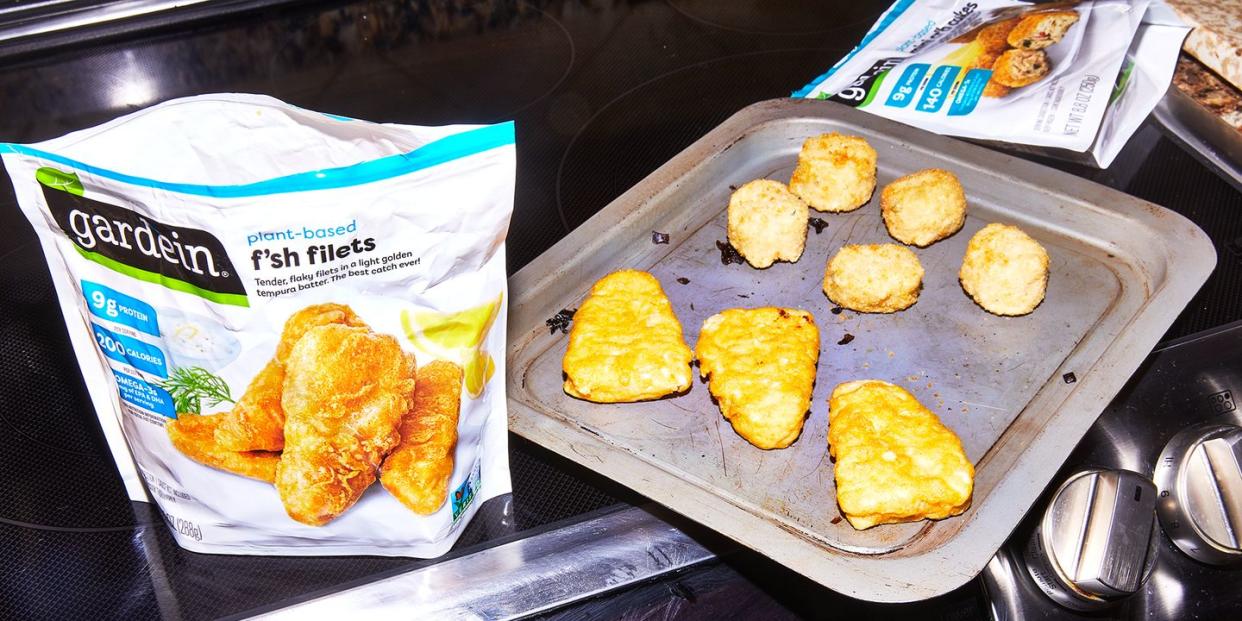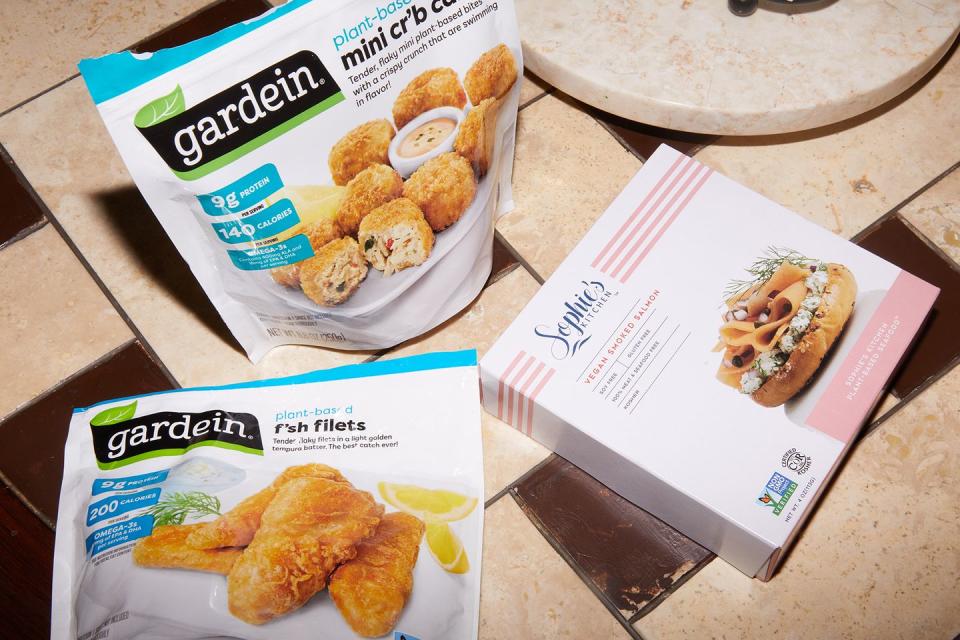Yes, Plant-Based Seafood is a Thing—and There are Pros and Cons to Eating It

"Hearst Magazines and Yahoo may earn commission or revenue on some items through the links below."
What a time to follow a plant-based diet. Not only can you find Impossible Chicken Nuggets, alongside the cult-favorite Mandarin Chicken at Trader Joe’s, you can also take your standard sub above and beyond via Subway’s Beyond Meatball Sub. Brands like Chipotle have even developed their own signature plant-based meat substitutes (their “chorizo” is made with spiced-up pea protein).
It’s no wonder these restaurants continue to add meat alternatives to their menus: 24 percent of Americans claim they’re trying to eat more plant protein, according to the 2021 Food and Health Survey from the International Food Information Council (IFIC). That same survey found that nearly two-thirds of respondents (65 percent) had already eaten items “that attempt to mimic the flavor and texture of animal protein but are made with only plant products,” in the previous year.
The mock meat doesn’t stop at, well, meat. One of Food Network’s predicted top food trends of 2022 was plant-based fish, citing documentaries like Chasing the Thunder, which discusses the impact of illegal fishing on people and the environment. Beef, long thought to be the biggest burden in the animal food production space, now sadly has some competition: farmed catfish, along with beef, generate the highest amounts of greenhouse gas emissions in production, according to a 2018 report published in the journal Frontiers in Ecology and the Environment.
To keep up with demand, food brands rose to the surface to fill the gap with animal-free alternatives to their fish dishes. Sales for plant-based seafood jumped 23 percent in 2020, and that market share and the array of products available continues to grow.
The question remains: Is plant-based seafood better for you—and for the environment?
What is plant-based seafood, exactly?
“Plant-based seafood essentially mimics the taste, texture, and the appearance of traditional seafood, but typically contains only vegan ingredients,” explains Michelle Hyman, R.D., a registered dietitian at Simple Solutions Weight Loss in New York City.
You can now find fish-free tuna, crab cakes, shrimp, caviar, fish sticks, fish burgers, breaded fish filets and more, which are often made of soy products, seaweed, yeasts, legumes, starches, seasonings, and oils. And coming soon: cellular-based (that means lab-grown, rather than plant-based) sushi-grade fish from Wild Type.
What kinds of plant-based seafood are available?

The ingredient list on many seafood alternatives often includes pea protein isolate (for protein), seaweed (for umami flavor) and/or wheat protein (to mimic seafood’s texture and to add more protein). Some recipes also incorporate algae oil for a dose of omega 3s—the heart-healthy fats that, alongside the protein, make regular seafood a perennial dietitian favorite.
Well-known plant-based brands like Gardein and Loma Linda, plus faux fish-focused ones including Sophie’s Kitchen and Caviart, have all cast their hooks into plant-based seafood.
To compare the texture and flavor to their conventional counterparts, we tried Gardein’s Mini Cr’b Cakes, which are wheat- and soy-based, plus Good Catch’s Plant-Based Fish Sticks, which have those same ingredients plus some chickpeas in the mix, as well as Sophie’s Kitchen’s Plant-Based Shrimp.
With plenty of seasonings and breading, and thanks to the crisp of the the air-fryer, these plant-based seafood choices taste pretty close to the real deal.
That said, more “naked” plant-based tuna and shrimp facsimiles can be tougher for manufacturers to ace taste and texture, because they can’t fake it with other elements like the breading. But Caviart is pretty spot-on with regular caviar, and they’re not the only ones; high-end restaurants like New York City’s Eleven Madison Park and Los Angeles’ PYT have dabbled in vegan caviar service.
What are the pros and cons of plant-based seafood?
The average American consumes about 16 pounds of seafood per year, per the National Fisheries Institute, with shrimp, salmon, canned tuna, tilapia, and pollock topping the charts. With Americans being so keen on adding heart-healthy fish to their diets, and because we have such a penchant for these most popular seafood varieties, a whopping 34 percent of fisheries are now overfished, according to the University of Washington’s Sustainable Fisheries division. This means that the rate of removal of the species is quicker than the rate it can reproduce, so the species is at higher risk for extinction.
Since plant-based formulations are (obviously) made with plants instead of actual seafood, the introduction of these faux-fish products may help move the needle on the overfishing issue.
It’s not quite fair to think of this as one-for-one trade, though, adds Frances Largeman-Roth, R.D.N., a Dobbs Ferry, New York-based nutrition expert and author of The Smoothie Plan—especially if we’re talking about nutrition.
“The biggest ‘pro’ of eating plant-based seafood is that you don’t have to worry whether you’re eating a species that is overfished. However, you are not getting the same nutritional benefit as eating real seafood,” Largeman-Roth says. “It’s well-documented that eating more seafood—the American Heart Association recommends two servings of fatty fish weekly—helps protect our hearts and reduces the risk of dying. The same can’t be said for these analogs.”
That’s because seafood is naturally high in seafood-derived omega-3s, DHA (docosahexaenoic acid) and EPA (eicosapentaenoic). All omega-3s are heart healthy, true. But faux fish is often supplemented with plant-based omega-3s, in the form of ALA (alpha-linolenic acid), which is less easily absorbed and utilized by the body. (You might see this reported in studies as EPA and DHA being more “bioavailable.”)
“Oily fish, such as salmon, sardines and mackerel contain DHA and EPA forms of omega-3 fatty acids. Even if the plant-based seafood contained omega-3s, it would be the ALA version, which is not the same. The human body’s ability to convert ALA to EPA and DHA is very limited,” Hyman explains.
Anyone with soy or wheat allergies or intolerances will be out of luck if they want to try most of the plant-based seafood products currently on the market, Largeman-Roth says. They are a boon, though, for vegetarians, vegans, or anyone looking to assist in stepping down animal-product consumption.
Hyman also suggests keeping a keen eye on the protein (often lower than their real seafood competitors), as well as the saturated fat and sodium (often higher than their real seafood competitors) on plant-based seafood nutrition facts panels.
“I consider plant-based seafood to be similar to bacon, sausage, and hot dogs in terms of being ultra-processed and much of the time, high in sodium. The plant-based alternatives provide fewer grams of protein than their traditional seafood counterparts per serving and the type of protein they contain is sometimes of lower biological value,” Hyman says.
Unless her clients are eschewing animal products entirely, Largeman-Roth advises them to stick with real fish that’s low in contaminants like those by Safe Catch. (The Environmental Defense Fund has a handy tool to help you compare the sustainability and safety of all major seafood selections.)
“I’ve tried the cans of ‘tuna,’ and they just didn’t do it for me. When I eat seafood, I try to choose wild Alaskan seafood because it’s wild-caught and low in contaminants. I like knowing that I’m eating something that is healthy for my brain and heart, and also happens to be delicious,” says Largeman-Roth. “I’d rather balanced out my seafood consumption with eating lots of produce, rather than plant-based seafood.”
The Bottom Line
There are environmental benefits of eating less meat and seafood, so if greenhouse gas emissions are a priority, feel free to give plant-based seafood a go. But just like an Impossible Burger isn’t going to be as protein-rich and low in additives as a grass-fed beef patty raised on a local farm, keep in mind that these faux-fish products should be viewed as a treat, a way to mix up your usual routine, rather than a staple in your diet.
“Plant-based versions of animal proteins, including plant-based seafood, are now so readily available that it is easy to become dependent on them for convenience,” Hyman says. “Plant-based seafood is a very interesting concept. However, if someone is choosing it because they believe it to be healthier than traditional seafood or other plant foods, they may want to reconsider.”
There are plenty of less processed, more nutritious plant-based proteins that she would recommend instead, such as beans, peas, lentils, nuts, and seeds, and ideally, we’d be mixing up our plate and including all of the above.
“It’s important to consume a varied and well-balanced diet,” Hyman adds. “If you’re concerned about the environment, you can also consider buying sustainable seafood. Look for the ‘Certified by the Marine Stewardship Council’ or ‘Best Aquaculture Practices’ labels.”
You Might Also Like

